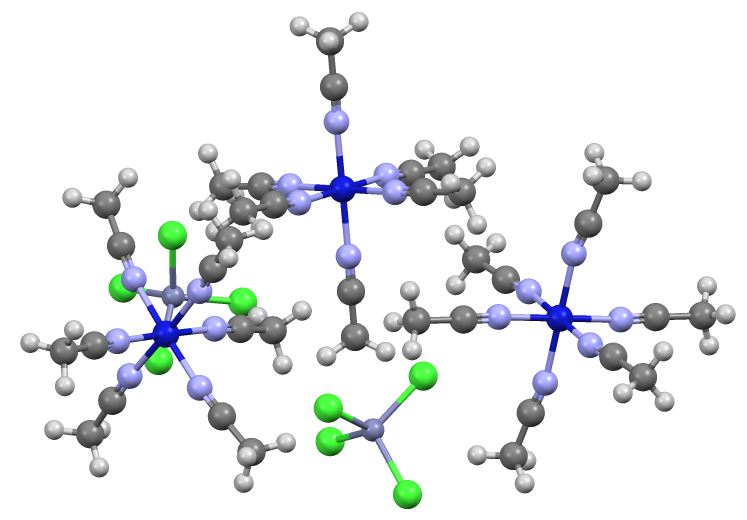|
Copper(I) Nitrate
Copper(I) nitrate is a proposed inorganic compound with formula of CuNO3. It has not been characterized by X-ray crystallography. It is the focus of one publication, which describes unsuccessful efforts to isolate the compound. Another nonexistent simple copper(I) compound derived from an oxyanion is cuprous perchlorate. On the other hand, cuprous sulfate is known. Derivatives The nitrate salt of the acetonitrile complex, i.e., u(MeCN)4O3, is generated by the reaction of silver nitrate with a suspension of copper metal in acetonitrile. :Cu + AgNO3 + 4 CH3CN → u(CH3CN)4O3 + Ag Tertiary phosphine complexes of the type u(P(C6H5)3)3O3 are prepared by the reduction of copper(II) nitrate Copper(II) nitrate describes any member of the family of inorganic compounds with the formula Cu( NO3)2(H2O)x. The hydrates are hygroscopic blue solids. Anhydrous copper nitrate forms blue-green crystals and sublimes in a vacuum at 150-200 ° ... by the phosphine. References ... [...More Info...] [...Related Items...] OR: [Wikipedia] [Google] [Baidu] |
Inorganic Compound
An inorganic compound is typically a chemical compound that lacks carbon–hydrogen bondsthat is, a compound that is not an organic compound. The study of inorganic compounds is a subfield of chemistry known as ''inorganic chemistry''. Inorganic compounds comprise most of the Earth's crust, although the compositions of the deep Mantle (geology), mantle remain active areas of investigation. All allotropes (structurally different pure forms of an element) and some simple carbon compounds are often considered inorganic. Examples include the allotropes of carbon (graphite, diamond, buckminsterfullerene, graphene, etc.), carbon monoxide , carbon dioxide , carbides, and salt (chemistry), salts of inorganic anions such as carbonates, cyanides, cyanates, thiocyanates, isothiocyanates, etc. Many of these are normal parts of mostly organic systems, including organisms; describing a chemical as inorganic does not necessarily mean that it cannot occur within life, living things. History ... [...More Info...] [...Related Items...] OR: [Wikipedia] [Google] [Baidu] |
X-ray Crystallography
X-ray crystallography is the experimental science of determining the atomic and molecular structure of a crystal, in which the crystalline structure causes a beam of incident X-rays to Diffraction, diffract in specific directions. By measuring the angles and intensities of the X-ray diffraction, a crystallography, crystallographer can produce a three-dimensional picture of the density of electrons within the crystal and the positions of the atoms, as well as their chemical bonds, crystallographic disorder, and other information. X-ray crystallography has been fundamental in the development of many scientific fields. In its first decades of use, this method determined the size of atoms, the lengths and types of chemical bonds, and the atomic-scale differences between various materials, especially minerals and alloys. The method has also revealed the structure and function of many biological molecules, including vitamins, drugs, proteins and nucleic acids such as DNA. X-ray crystall ... [...More Info...] [...Related Items...] OR: [Wikipedia] [Google] [Baidu] |
Cuprous Sulfate
Copper is a chemical element; it has symbol Cu (from Latin ) and atomic number 29. It is a soft, malleable, and ductile metal with very high thermal and electrical conductivity. A freshly exposed surface of pure copper has a pinkish-orange color. Copper is used as a conductor of heat and electricity, as a building material, and as a constituent of various metal alloys, such as sterling silver used in jewelry, cupronickel used to make marine hardware and coins, and constantan used in strain gauges and thermocouples for temperature measurement. Copper is one of the few metals that can occur in nature in a directly usable, unalloyed metallic form. This means that copper is a native metal. This led to very early human use in several regions, from . Thousands of years later, it was the first metal to be smelted from sulfide ores, ; the first metal to be cast into a shape in a mold, ; and the first metal to be purposely alloyed with another metal, tin, to create bronze, . Commonly ... [...More Info...] [...Related Items...] OR: [Wikipedia] [Google] [Baidu] |
Acetonitrile Complex
Transition metal nitrile complexes are coordination compounds containing nitrile ligands. Because nitriles are weakly basic, the nitrile ligands in these complexes are often labile. Ligand properties According to the Covalent bond classification method, nitriles are classified as L ligands, i.e., charge-neutral Lewis bases. With respect to HSAB theory, they are classified as soft. Typical nitrile ligands are acetonitrile, propionitrile, and benzonitrile. The structures of u(NH3)5(NCPh)sup>n+ have been determined for the 2+ and 3+ oxidation states. Upon oxidation the Ru-NH3 distances contract and the Ru-NCPh distances elongate, consistent with amines serving as pure-sigma donor ligands and nitriles functioning as pi-acceptors. Synthesis and reactions Acetonitrile, propionitrile and benzonitrile are also popular solvents. Because nitrile solvents have high dielectric constants, cationic complexes containing a nitrile ligand are often soluble in a solution of that nitrile. Some ... [...More Info...] [...Related Items...] OR: [Wikipedia] [Google] [Baidu] |
Copper(II) Nitrate
Copper(II) nitrate describes any member of the family of inorganic compounds with the formula Cu( NO3)2(H2O)x. The hydrates are hygroscopic blue solids. Anhydrous copper nitrate forms blue-green crystals and sublimes in a vacuum at 150-200 °C. Common hydrates are the hemipentahydrate and trihydrate. Synthesis and reactions Hydrated copper(II) nitrate Hydrated copper nitrate is prepared by treating copper metal or its oxide with nitric acid: : The same salts can be prepared treating copper metal with an aqueous solution of silver nitrate. That reaction illustrates the ability of copper metal to reduce silver ions. In aqueous solution, the hydrates exist as the aqua complex . Such complexes are highly labile and subject to rapid ligand exchange due to the d9 electronic configuration of copper(II). Attempted dehydration of any of the hydrated copper(II) nitrates by heating affords the oxides, not . At 80 °C the hydrates convert to "basic copper nitrate", , which con ... [...More Info...] [...Related Items...] OR: [Wikipedia] [Google] [Baidu] |

